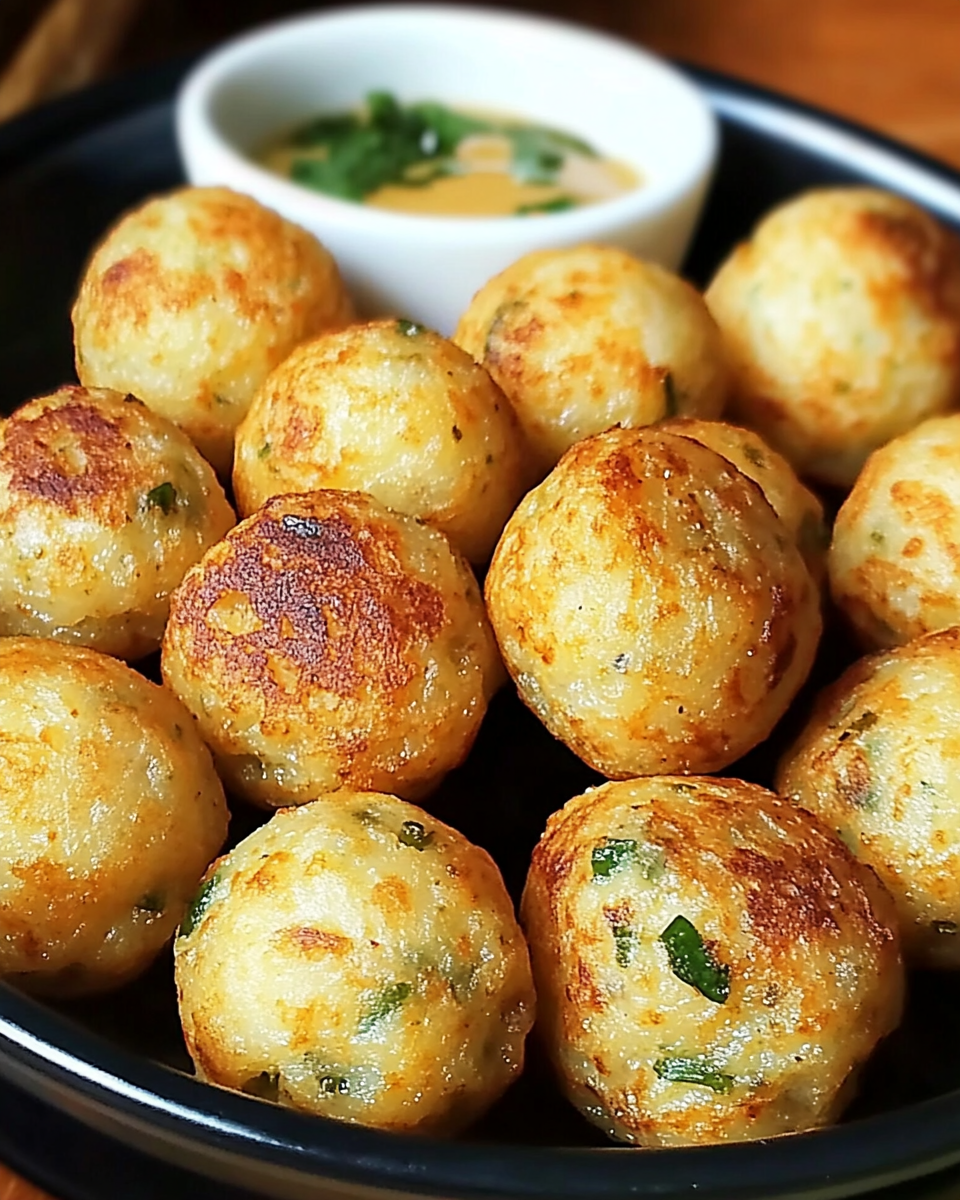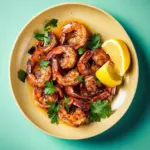Kuzhi Paniyaram is a beloved South Indian delicacy made from fermented rice and urad dal batter. These bite-sized dumplings are crispy on the outside and soft on the inside, with a subtle blend of spices and fresh vegetables that make each bite flavorful and comforting. The beautiful golden-brown paniyarams served hot with coconut chutney or sambar make for a wholesome and satisfying snack or breakfast option.
What sets this dish apart is its simplicity and versatility. Whether you keep it plain or add your favorite veggies and spices, paniyaram is a quick-to-make treat that is perfect for any time of the day. Its crisp texture and mildly tangy taste from the fermented batter are sure to delight your taste buds and bring a taste of authentic South Indian home cooking to your table.
Full recipe:
Ingredients:
-
1 cup idli/dosa batter (fermented rice and urad dal batter)
-
1 small onion, finely chopped
-
1 green chili, finely chopped
-
1/4 cup grated carrot (optional)
-
1 tablespoon coriander leaves, chopped
-
1/2 teaspoon mustard seeds
-
1/2 teaspoon urad dal
-
A pinch of asafoetida (hing)
-
Salt, to taste
-
Oil, for cooking
Directions:
-
Heat a paniyaram pan (appe pan) on medium heat and add a few drops of oil in each cavity.
-
In a small pan, heat a teaspoon of oil and add mustard seeds and urad dal. Once they splutter and turn golden, add asafoetida and pour this tempering into the batter.
-
Add chopped onions, green chilies, grated carrot, coriander leaves, and salt to the batter. Mix gently.
-
Pour a spoonful of batter into each cavity of the paniyaram pan, filling it about three-quarters full.
-
Drizzle a little oil on top of each paniyaram. Cover with a lid and cook on medium heat for 3-4 minutes or until the bottoms turn golden and crisp.
-
Flip each paniyaram carefully using a skewer or spoon and cook the other side for another 3 minutes until golden brown and crisp.
-
Remove and serve hot with coconut chutney or sambar.
Prep Time: 10 minutes | Cooking Time: 15 minutes | Total Time: 25 minutes
Kcal: Approximately 120 kcal per serving | Servings: 4 servings
Cultural Significance and Popularity
Paniyaram holds an important place in South Indian households, especially for breakfast or evening snacks. Its simplicity and use of fermented batter reflect the age-old culinary traditions of the region, where fermentation enhances flavor, texture, and nutritional benefits. Traditionally, paniyaram is made using freshly fermented batter, which imparts a slight tanginess and aids digestion.
In many South Indian festivals and family gatherings, paniyaram is a staple item served with coconut chutney, tomato chutney, or spicy sambar, making it a crowd favorite. The dish’s popularity has also crossed regional borders and can be found in many Indian restaurants worldwide. Modern variations of paniyaram include sweet versions with jaggery and coconut or stuffed varieties with spicy fillings, which demonstrate its adaptability and evolving nature.
The Science Behind the Fermentation
A key factor that sets paniyaram apart from many other snacks is the use of fermented batter. The process of fermentation breaks down complex carbohydrates into simpler compounds, making the food easier to digest and enhancing nutrient absorption. The rice and urad dal batter, left to ferment overnight, develops beneficial probiotics, contributing to gut health.
Fermentation also creates a slight tangy flavor that adds depth to the otherwise simple ingredients. The airiness and softness inside the paniyaram are a direct result of the fermentation process, which produces natural leavening. This makes the dish not only delicious but also wholesome and beneficial for digestive health.
Health Benefits of Kuzhi Paniyaram
Kuzhi Paniyaram, when prepared traditionally, is a relatively healthy snack or breakfast choice. The main ingredients, rice and urad dal, are staples in Indian cuisine and offer numerous health benefits. Urad dal is rich in protein and fiber, while rice provides essential carbohydrates for energy.
Because the batter is fermented, the probiotics contribute positively to the gut microbiome, supporting digestion and immunity. The cooking method uses minimal oil, especially when using a non-stick paniyaram pan, making it lower in fat compared to deep-fried snacks. Adding vegetables such as onions, green chilies, and carrots increases the fiber and vitamin content, making this dish nutritionally balanced.
For those following gluten-free diets, paniyaram is an excellent choice since rice and urad dal are naturally gluten-free. It can also be made vegan easily since it contains no dairy or eggs by default, aligning with many dietary preferences.
Versatility in Variations and Serving Styles
While the classic savory paniyaram is the most popular, this dish is incredibly versatile. Sweet versions can be made by adding jaggery, coconut, and cardamom powder to the batter, creating a delightful dessert or breakfast treat. Another creative variation is stuffing paniyaram with spicy potato or vegetable fillings, which adds a surprise element to each bite.
Paniyaram can be served with a wide array of accompaniments. Coconut chutney, made with fresh grated coconut and tempered with mustard seeds, curry leaves, and green chilies, is a classic pairing that complements the mild tangy flavor of the dumplings. Sambar, a tangy lentil and vegetable stew, also pairs beautifully with paniyaram and adds warmth and spice.
In modern fusion cuisine, paniyaram is sometimes served with tomato ketchup, peanut chutney, or even spicy yogurt dips to cater to diverse palates. It is also popular as a party snack or appetizer due to its perfect bite size and appealing crispiness.
The Special Paniyaram Pan
A distinctive feature of this dish is the special pan used to cook it, known as the paniyaram pan or appe pan. This cast iron or non-stick pan contains several small, round cavities where the batter is poured and cooked. The design allows the batter to cook evenly, developing a crisp outer shell while maintaining a soft inside.
This pan is similar in concept to the Danish Æbleskiver pan or the Japanese Takoyaki pan but is specifically designed for Indian-style dumplings. The cavities help the batter hold its shape and facilitate flipping the paniyaram midway through cooking for even browning.
Owning a paniyaram pan is considered essential for authentic preparation, although in a pinch, small muffin tins or other similar cookware can be used, albeit with slightly different results.
Tips for Perfect Kuzhi Paniyaram
Achieving the perfect paniyaram requires some attention to detail. The batter consistency should be similar to that used for idlis and dosas—neither too thick nor too watery. Freshly fermented batter ensures the lightest and softest results.
Temperature control is crucial; cooking on medium heat ensures that the paniyaram become golden and crispy without burning. Using oil sparingly but evenly coats the cavities, helping to develop a crisp crust.
Flipping the dumplings carefully and quickly allows even cooking on both sides. Patience during cooking is key to get the perfect texture. Adding finely chopped onions, chilies, and coriander to the batter enhances flavor and makes the snack more interesting.
Why Kuzhi Paniyaram is a Must-Try
For anyone exploring Indian cuisine, Kuzhi Paniyaram offers a fantastic introduction to the world of fermented rice dishes and South Indian cooking techniques. Its balance of textures and flavors is unique yet accessible, making it a favorite for children and adults alike.
Unlike many complicated recipes, paniyaram is quick to prepare, requires minimal ingredients, and brings the joy of homemade snacks to your table. It’s also an excellent way to use leftover idli or dosa batter, reducing food waste.
The recipe’s adaptability, health benefits, and delicious taste make it a must-try for food enthusiasts looking for authentic regional flavors with a modern twist.
Conclusion
Kuzhi Paniyaram is more than just a snack; it is a celebration of South Indian culinary heritage, showcasing the beauty of simplicity, fermentation, and balanced flavors. Its crisp exterior paired with the soft, airy interior makes it irresistibly delicious, while the batter’s fermentation adds healthful benefits that traditional cooking methods honor.
This dish fits perfectly into a modern lifestyle, whether you want a quick breakfast, an afternoon snack, or a comforting addition to your meal. Easy to make, versatile, and packed with flavor, Kuzhi Paniyaram invites you to experience the magic of South Indian cooking in every bite. Whether served with chutney or sambar, sweet or savory, it promises a memorable eating experience that is sure to delight and satisfy.






